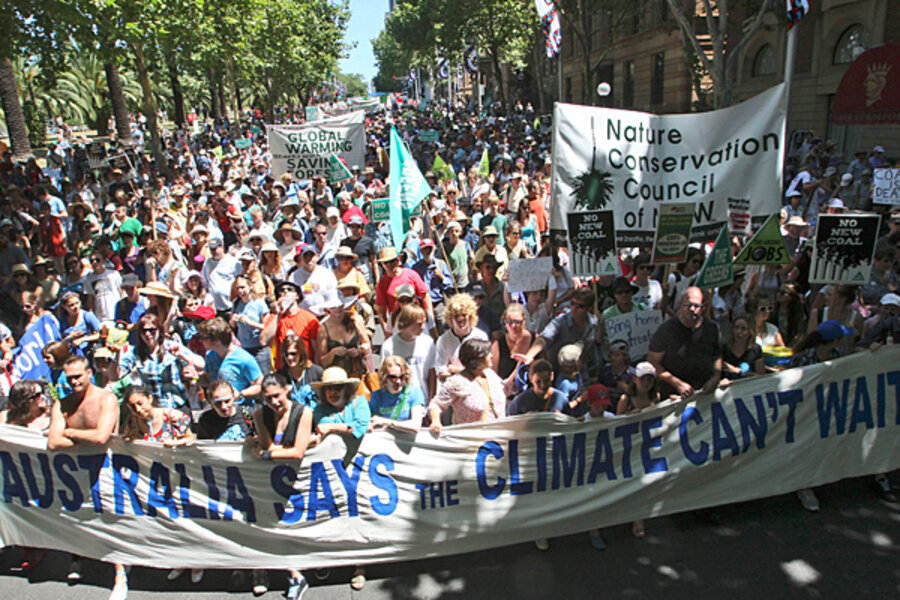Global warming threatens Australia's beach life
Loading...
| Sydney, Australia
A two-mile arc of golden sand in Sydney’s northern suburbs, Collaroy Beach is a beautiful spot. “I wouldn’t live anywhere else,” declares Roger Wright, watching surfers bob in the waves on a recent afternoon.
But Collaroy is not always so idyllic. During severe storms, the beach is lashed by mountainous seas that strip away tons of sand and lap at the gardens of beachside properties. Fences have been washed away and living rooms flooded. Sometimes children can jump straight into the ocean from their backyards.
Long affected by natural erosion, Collaroy now faces additional pressures: It is one of three coastal stretches in Australia identified as most vulnerable to global warming. With scientists predicting more frequent and severe storms, exacerbated by rising sea levels, the multimillion dollar properties along its beachfront are considered at serious risk.
The situation is mirrored around the country; indeed, a recent parliamentary report here warned that thousands of miles of coastline, and billions of dollars of property and infrastructure, are under threat. The committee called for a ban on new development in sensitive areas and raised the possibility of the government forcing people to abandon prime beachfront homes.
The report sent a shiver through a country where the beach, the surf, and the right to a seaside lifestyle are almost sacrosanct. And it adds fuel to local government efforts to curb coastal building. Eighty percent of Australia's population lives within 30 miles of the water, and that proportion is steadily growing. But with sea levels projected to rise globally – if greenhouse gas emissions continue unchecked – by about three feet by 2100, the concentration of people on the coast presents enormous challenges.
Mr. Wright, who lives in an apartment overlooking the ocean, is not worried. “I wouldn’t dream of moving,” he says. “I’ve lived here for 25 years and it’s always the same. The king tides wash away the sand, then the sand comes back. I don’t believe it’s going to get worse – and if it does, I’ll be in the ground by then.”
Pulling people back from the coast
Planners and policymakers are less sanguine, particularly at the local level, where some municipal councils are already locked in conflict with residents. At Byron Bay, another climate change “hot spot,” on the northern New South Wales coast, wealthy owners of beachside properties are threatening to sue the council over its refusal to allow them to build protective sea walls.
Byron council – which believes such walls could seriously degrade a popular public beach – has a policy of “planned retreat,” requiring people to relocate as the coastline recedes. No one has been forced to move yet, but the ban on building barriers against the encroaching sea makes that a real possibility in the future. In more developed areas such as Sydney, meanwhile, the policy is not an option for local authorities. “In the urban environment, there’s really nowhere to retreat to,” says Andy Short, director of the Coastal Studies Unit at Sydney University.
In Collaroy, the council has bought and demolished 10 properties on the beach strip. They include a house next to Mr. Wright’s block, purchased for A$3 million ($2.73 million). The site is now grassed over, and partly occupied by a small parking lot, the building having been demolished because of the threat of the advancing ocean.
Like other high-risk sites, Collaroy's moves are largely a legacy of bad planning. When property boundaries were established more than a century ago, they were fixed too close to the shoreline. Back then, town planners were unaware of the risks. However, development continued apace on the shifting sands even after the waves claimed seven beach shacks in 1944-45, and another in 1967. During ferocious storms two years ago, two apartment buildings nearly collapsed.
The beach is lined with protective piles of boulders and concrete slabs. But, like Mr. Wright, locals are not concerned about the future. “Everyone here loves the beach, so the benefits outweigh the scare factor,” says Lauren Warne, a student. Seated on the dunes, gazing out to sea, Robyn Friend says: “If it’s going to happen, it’s going to happen. There’s not much you can do.”
Calls for coordinated action
Nationally, though, there is a new urgency to the climate change debate, which until recently focused largely on the increased risk of drought and bushfires. The recent parliamentary report, with its warning that more than 700,000 coastal homes are vulnerable, made for sobering reading.
The report also deplored the “piecemeal” approach being adopted by local and state governments – a problem acknowledged by Alan Stokes, director of the National Sea Change Taskforce, which represents coastal councils. “We need a consistent and coordinated national policy framework,” says Mr. Stokes.
Sydney University's Professor Short says that Australians need to rethink the way they live. “We can still live in the coastal zone, but not right on the coast,” he says. “We will see erosion which exceeds any past erosion events. Beaches will retreat to a degree they have never done in the past.”
And what about areas like Collaroy? “If nothing is done, more houses will be washed away. These houses will just one by one fall into the sea."





